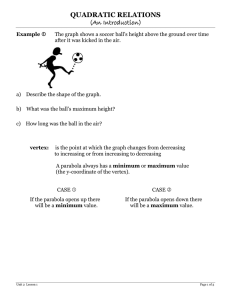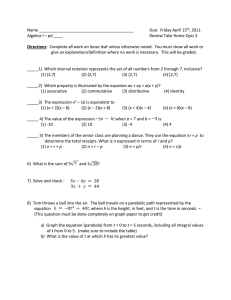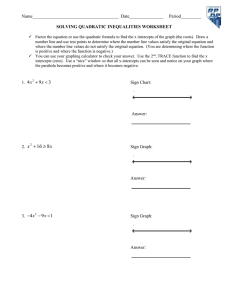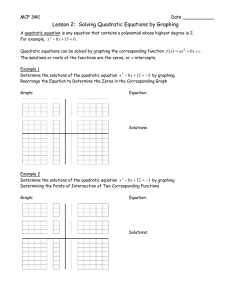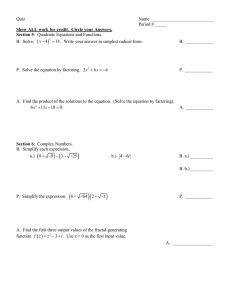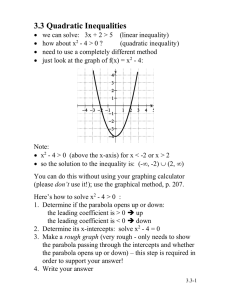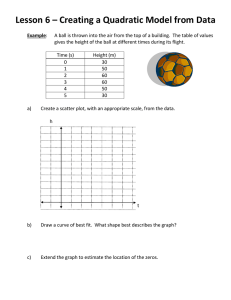Solving Quadratic Functions: Problems & Strategies
advertisement
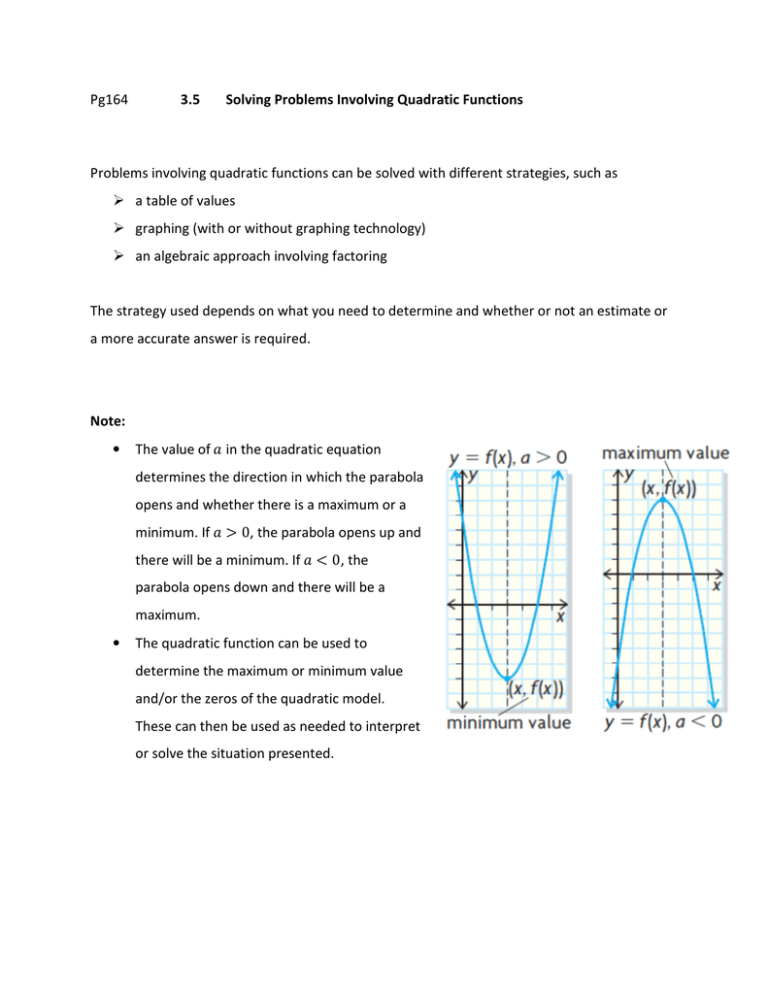
Pg164 3.5 Solving Problems Involving Quadratic Functions Problems involving quadratic functions can be solved with different strategies, such as a table of values graphing (with or without graphing technology) an algebraic approach involving factoring The strategy used depends on what you need to determine and whether or not an estimate or a more accurate answer is required. Note: • The value of in the quadratic equation determines the direction in which the parabola opens and whether there is a maximum or a minimum. If > 0, the parabola opens up and there will be a minimum. If < 0, the parabola opens down and there will be a maximum. • The quadratic function can be used to determine the maximum or minimum value and/or the zeros of the quadratic model. These can then be used as needed to interpret or solve the situation presented. Example 1 A computer software company models the profit on its latest video game using the function = −2 + 32 − 110, where is the number of games, in thousands, that the company produces and is the profit, in millions of dollars. Determine the maximum profit. = −2 + 32 − 110 = −2 − 16 + 55 0 −2 − 5 − 11 = ℎ ÷ −2 −2 −2 0 = − 5 − 11 − 5 = 0 − 11 = 0 = 5 = 11 ℎ= 5 + 11 16 = =8 2 2 8 = −28 + 328 − 110 = −128 + 256 − 110 = 18 The maximum profit is $18, 000,000. Example 2 Sally is standing on the top of a river slope and throws a ball. The height of the ball at a given time is modeled by the function ℎ = −5 − 10 + 250, where ℎ is the height in meters and is time in seconds. When will the ball be 10 m above the ground? ℎ = −5 − 10 + 250 10 = −5 − 10 + 250 5 + 10 − 250 + 10 = 0 5 + 10 − 240 = 0 + 2 − 48 = 0 − 6 + 8 = 0 −6=0 +8=0 =6 = −8 , ≥ 0 The ball will be 10 m above the ground at 6 s. Homework Pg169 #8~10 #8. ℎ = −0.15 + 3 10 = −0.15 + 3 0.15 − 3 + 10 = 0 = 0.15, = −3, $ = 10 = − ± √ − 4$ 2 = 3 ± '−3 − 40.1510 20.15 = 3 ± √9 − 6 3 ± √3 = 0.3 0.3 ) = 3 + √3 ≅ 15.77 0.3 = 3 − √3 ≅ 4.23 0.3 #9. Method 1: complete the square Method 2: factoring = −2$ + 14$ − 20 = −2$ + 14$ − 20 = −2$ − 7$ + 3.5 − 3.5 − 20 0 = −2$ + 14$ − 20 = −2$ − 7$ + 3.5 − 2−3.5 − 20 0 = −2$ − 7$ + 10 = −2$ − 3.5 + 24.5 − 20 0 = $ − 2$ − 5 = −2$ − 3.5 + 4.5 $−2=0 $−5=0 $=2 $=5 ℎ= 2+5 = 3.5 2 , = −23.5 + 143.5 − 20 = 4.5 The maximum profit is $450 000. #10. Method 1: (Partial Factor) Method 2: (complete square) Let ℎ = $ ℎ = 65 + 10 − 5 65 = 65 + 10 − 5 ℎ = −5 + 10 + 65 0 = −5 + 10 ℎ = −5 − 2 + 1 − 1 + 65 −5 − 2 = 0 ℎ = −5 − 2 + 1 − 5−1 + 65 −5 = 0 −2=0 ℎ = −5 − 1 + 5 + 65 =0 =2 ℎ = −5 − 1 + 70 ℎ= 0+2 =1 2 The ball reaches the maximum height at 1 second. The ball reaches the maximum height at 1 second.
